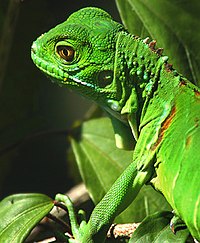Green iguana
| Green Iguana | |
|---|---|

| |
| Wild Green Iguana | |
| Scientific classification | |
| Kingdom: | |
| Phylum: | |
| Class: | |
| Order: | |
| Family: | |
| Genus: | |
| Species: | I. iguana
|
| Binomial name | |
| Iguana iguana | |
The green iguana (Iguana iguana) is a large, arboreal lizard from Central and South America. The green iguana is found over a large geographic area, from Mexico to southern Brazil and Paraguay, as well as on the Caribbean Islands and Florida. They are typically about two metres in length from head to tail and can weigh up to five kg.
Sexing
It is possible to determine the sex of a Green iguana by examining the underside of the hind legs. Males have highly developed pores in this area that secrete scent, and are often covered in a waxy substance. In addition, the spiny scales that run along an iguana's back are noticeably longer and thicker in males than they are in females. Recent discoveries have shown that iguanas, along with several other species popularly kept as pets, are actually venomous. However, their venom is not produced in sufficient quantities to be harmful to humans. [1]
Behaviour
Green iguanas are diurnal and strictly herbivorous, feeding on leaves, flowers, fruit, and growing shoots (they might occasionally consume insects and other small animals, especially in youth, but it has been argued that this only occurs under conditions of stress and poor food availability [2]). They can be found living in trees and near water, into which they will dive if frightened. Agile climbers, they can fall up to 40 feet without being injured, and can run quickly despite their clumsy appearance. Because of their popularity in the pet trade and as food in Latin American countries, green iguanas are listed on the CITES Appendix II, which means they are considered a threatened species.
When threatened by a potential predator, Green Iguanas will attempt to flee. If near a water source, they will dive into the water and swim off. If cornered or else unable to escape, they will display the dewlap under their head, puff up their bodies, and display an elaborate head-bobbing movement to the perceived threat.
Captivity

These lizards recently became extremely popular in the pet trade—over 800,000 animals were imported into the United States alone during 1995, mainly coming from captive farming operations based in the country of origin. Despite the apparent "mass market" appeal of these animals they are very demanding to care for properly over their lifetime, and the majority die within a few years of acquisition. In 1998 a National Iguana Awareness Day (NIAD) was established to discourage consumers from viewing iguanas as "throwaway pets".
Many ignorant buyers are tempted by the price of young iguanas and apparent low cost of feeding, and typically give them inappropriate food and insufficient housing without adequate sources of heat. Although they will consume a wide variety of foods if offered, green iguanas are naturally herbivores and require a precise ratio of vitamins in their diet. The question whether captive green iguanas should be fed animal protein is controversial; while some have recommended such additions, as they are known to enhance the growth of the animal, others, such as zoologist Adam Britton, believe that such a diet is likely to cause excessive protein intake, which the iguana's naturally herbivorous digestion system can't handle, resulting in severe long-term health damages and early death. [3] Green iguanas will thrive only in temperatures of 75 to 90 degrees Fahrenheit (24 to 32 degrees Celsius) and must have appropriate sources of UVB and UVA lighting. Without proper UVB lighting they can develop metabolic bone disease which can be fatal if not treated.
If properly cared for, a captive green iguana can live anywhere from eight to 20 years.
References
-
A large male Iguana and a smaller immature female Iguana in captivity
-
Green Iguana in captivity
-
A young iguana in the wild
-
An old, male green iguana
-
A young Green Iguana catches the sun
-
A Green Iguana resting on a trunk
-
A male iguana in the wild (BCI, Panama)




